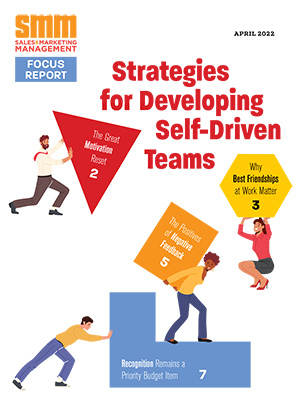After nine years working with companies on sales messaging, I have found that the number one inhibitor to salespeople articulating value is that they don’t create enough contrast between the before and after word picture of owning their product. And when salespeople fail to make the contrast feel concrete, customers can’t see the value, so it just feels like magic.
Salespeople, for instance, fail to create contrast when they only offer superficial reasons to change, such as the customer’s current system lacks timeliness or is prone to error. And when you ask salespeople what they mean by the customer’s system lacks timeliness, they push back, because they don’t know the answer. What you discover is that they have product knowledge, but only limited customer knowledge.
Without clearly articulating “the hell if the customer doesn’t buy their product,” the salesperson hasn’t set up the need for “the heaven if the customer does buy their product.” Without contrast, salespeople are just trying to rescue customers who are only ankle deep in problems. As a result, customers either stick with the status quo or they buy at a discount, because they don’t see the value of change. With 40 percent of B2B sales opportunities ending in no decision, selling change is a big part of articulating value.
Indeed, customers are not ready to believe in the viability of the salesperson’s product until they realize that they are out in the middle of the lake drowning in problems. This will only happen when the salesperson makes the contrast feel real by making it concrete. To sell change, the salesperson must specifically show how the customer’s current system/platform/product isn’t working optimally today. Once the customer can see how they aren’t doing it well today, it’s easy for them to see how their results could be improved by the salesperson’s product. But if the salesperson can’t make the contrast feel concrete, then the prospect can’t picture it in their head. It’s abstract. It doesn’t feel real. The salesperson is just asking the customer to take their word for it that their product creates value. It’s magic.
Specifics Win the Sale
Naturally, salespeople at first try to make their message general, because they believe it will then appeal to a wider audience; however, what they find is that it appeals to no one, because it’s abstract. But by making their before word picture concrete, the customer may say their situation is slightly different, but at least they get it. It’s counterintuitive that the universality of the salesperson’s message is found in the specificity of before picture.
For example, I was working with a salesperson who wanted to encourage a client to move their learning management system from their ERP system to the cloud. The salesperson created contrast by preparing an effective “hell if they don’t” move to the cloud picture by stating that “innovation had made Ellen’s corporate learning management system out of step with how employees expected to consume information, because she only received quarterly updates three times a decade when the ERP system was updated.”
But the contrast was still vague, because I couldn’t picture in in my head how the learning management system is out of step with how employees expect to consume information. So I asked the salesperson to be more concrete by providing a specific example, and she said “to access a course, for example, employees had to click on a link that would then take them to the homepage for learning, only to then be forced to search through a maze of information for the required course. No wonder drop offs were so high.”
Although this specific example may be different for the customer, the customer is now able to visualize the problem, and is now able to retrieve their own example of how their current system is negatively impacting their results today.
So, if you want to see if your salespeople are able to make the value of your product feel real, instead of feel like magic, then ask them to share a customer story that highlights one of your unique capabilities. Because a customer story presents a clear before and after picture of owing your product, the knowledge gaps of your salespeople will immediately be exposed when the word picture is out of focus. The picture, for example, will be vague:
- When they gloss over the before picture, and then prematurely rush to rescue the customer with your product
- When they fail to make the before picture real by specifically showing how the customer’s current system/platform/product isn’t working today
If you can’t picture it in your head, it’s going to feel like magic to the customer.
If your salespeople aren’t providing context, then aren’t they just presenting your product and hoping that the customer can figure out how they will use it, or even worse, care?
Imagine if selling was so simple that all you had to do was create five to 10 top stories, and then have your salespeople deliver them to better engage customers and drive more sales. Unfortunately this doesn’t work for the following three reasons:
- Every customer is slightly different so the salesperson must adapt the stories to suit the customer’s unique situation.
- Salespeople are more likely to adopt new sales messaging if they were involved in creating it.
- Salespeople need to know what a bad story is before they can appreciate a good story.
To help your salespeople better articulate value, we would suggest you split your salespeople up into five to eight groups to create and then deliver customer stories so that the group is then able to hear a story that pops, one that flops, and a few in the middle. Once your salespeople learn how to brainstorm on how they can improve each other’s stories, the quality of the edited stories will not only improve by 2x, but more important, when one flops, you will see the group physically recoil in disgust, because they have internalized what good feels like.
So imagine what would happen if you could improve the ability of your salespeople to articulate value by 2x? Could you then increase sales? According to a survey by SiriusDecision, sales leaders for the past four years in a row have said that the No. 1 barrier preventing salespeople from achieving quota is their inability to articulate value. And according to a recent survey of executive buyers by Gartner, customers agree. Only 34 percent of executive buyers, for example, feel that salespeople can articulate value, because they talk too much about their product. The survey concludes that salespeople will better articulate value when they talk less about their product and instead share more customer stories. 70 percent of these executive buyers, for example, felt that “customer stories and case studies are the best way that providers can communicate differentiation that I trust.”
With so much riding on your sales team’s ability to articulate value, ask yourself if your salespeople are able to make the value of your product feel real, or does it sound like magic to the customer?
Michael Harris is CEO of sales training provider Insight Demand.


